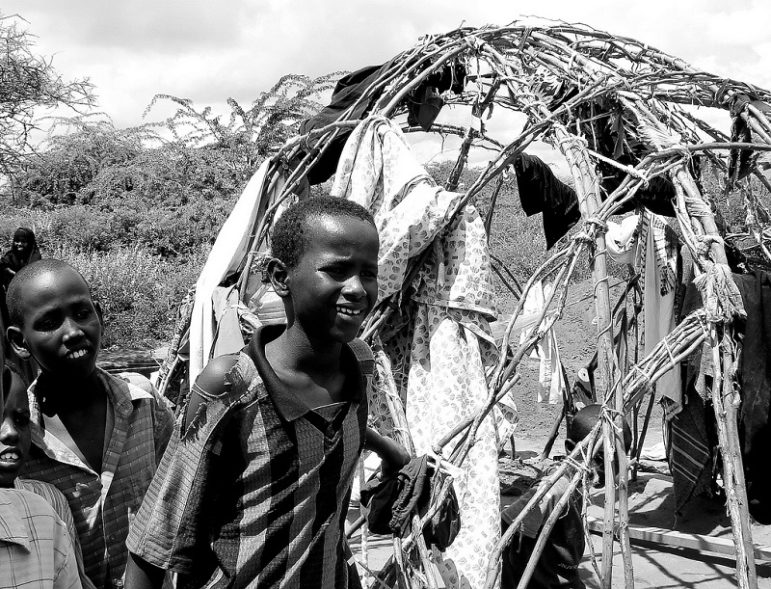
May 11, 2016, Reuters News and The Guardian
In a statement issued on May 6, 2016, the Kenyan Ministry of Interior announced it has disbanded the Department of Refugee Affairs (DRA) and indicated that it would close its Kakuma and Dadaab refugee camps within a year.
According to international law, refugees need to apply for resettlement in another country, return to their country of origin, or integrate into their country of asylum. None of these options appear open to Dadaab refugees.
Dadaab is the world’s largest refugee camp, constructed between 1991 and 1992. Managed by the Office of the United Nations High Commissioner for Refugees (UNHCR), other organizations are directly in charge of specific aspects of the refugees’ lives. These organizations issued a joint statement imploring the Kenyan government to reconsider:
Shutting down the refugee camps will mean increased protection risks for the thousands of refugees and asylum seekers—[the] majority of who are women, children and unaccompanied minors. […] The current humanitarian situation in Somalia and South Sudan remains dire and fragile. Somalia is faced with drought and other security risks that are likely to see an increase in displacement and vulnerability.
Since Kenya’s military invaded Somalia in 2011 to pursue the al-Shabaad terrorist group, there have been more than 100 terror attacks in Kenya, such as when four gunmen murdered 147 students at Garissa University. In April 2015, Kenya demanded that the United Nations remove the refugees from Dadaab, but ultimately withdrew the threat. Kenyan authorities are now renewing their demands.
Sign up for our free newsletters
Subscribe to NPQ's newsletters to have our top stories delivered directly to your inbox.
By signing up, you agree to our privacy policy and terms of use, and to receive messages from NPQ and our partners.
Kenya’s refugee camps pose security challenges. The mastermind of the Garissa University attack apparently had a support network in Dadaab. Nevertheless, the international community claims that any security gains from closing Dadaab would be eclipsed by the violence it would likely fuel. If refugees were forced back to Somalia, some would likely join al-Shabaab in search of protection or income in a country with few opportunities. Somalia already holds more than one million internally displaced persons. The humanitarian as well as security consequences of Kenya’s plan are grave.
The refugees arriving on Europe’s shores are a fraction of the some 60 million displaced people worldwide. Most refugees live in camps such as the Somalis in Kenya who fled their endless civil war. A new report by the Norwegian Refugee Council’s Internal Displacement Monitoring Center (IDMC) says the number of people throughout the world who were uprooted from their homes due to conflicts and natural disasters stands at the highest figure ever recorded.
As attention fades, so does the funding for the refugees in Kenya that the world seems to have forgotten. The World Food Program (WFP) dropped food rations in Dadaab by 30 percent in 2015. In other words, the daily nutrition refugees receive is a third less than the minimum recommended by the UN itself. If anything, Kenya is forcing the UN to find the wherewithal to help Kenya care for this beleaguered people.
Where is the international response to the needs of Kenya? NPQ asked this question in relation to the 2015 Garissa University tragedy. “Where is everyone?” is the title of a report produced by Médecins Sans Frontières/Doctors without Borders (MSF) that NPQ reviewed:
While international organizations have seen increases in their fundraising efforts, their direct impact in the developing world has decreased significantly. The report highlighted a number of issues and made assertions that ranged from “Humanitarian responses are slow and cumbersome and lack impact” to “UN agencies and INGOs are increasingly absent from field locations” and “when assistance is most needed, international staff of humanitarian agencies are rapidly evacuated or go into hibernation.”
The Kenyan government is also now, again, asking the world community: Where are you? However brutal and misguided their intentions may be in managing their refugee and security crises, it is a global humanitarian responsibility. There are no easy answers or solutions, and so many lives weigh in the balance.—James Schaffer













